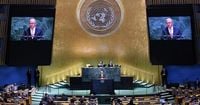As the United Nations General Assembly (UNGA) convened in New York City this week, drawing more than 150 world leaders to the city, U.S. security agencies revealed they had dismantled a sophisticated network of devices capable of crippling the region’s telecommunications infrastructure. The operation, led by the U.S. Secret Service with support from the New York Police Department (NYPD) and multiple federal agencies, unfolded just as President Donald Trump prepared to address the assembly on September 23, 2025.
According to the Metro and TND, the Secret Service discovered and seized more than 300 SIM servers and over 100,000 cellphone SIM cards in locations throughout the greater New York metropolitan area. The hardware was concentrated within a 35-mile radius of the UN headquarters, where security was already heightened due to the influx of international dignitaries. The plot, officials believe, was connected to the Chinese government, though other sources and security experts have also pointed to Russia or Iran as potential actors in similar attacks.
The scale and sophistication of the operation left officials stunned. Secret Service Director Sean Curran, in a statement cited by TND and Metro, emphasized, “The potential for disruption to our country’s telecommunications posed by this network of devices cannot be overstated.” He added, “The U.S. Secret Service’s protective mission is all about prevention, and this investigation makes it clear to potential bad actors that imminent threats to our protectees will be immediately investigated, tracked down and dismantled.”
The plot first came to light in the spring of 2025, when agents were tipped off during an investigation into threats made against three individuals, including one with direct access to President Trump. As the probe deepened, agents stumbled upon the network of devices, which were capable of sending up to 30 million anonymous text messages per minute—enough, experts say, to bring the city’s interconnected phone systems to a grinding halt.
International security expert Will Geddes, speaking to Metro, explained the gravity of the potential attack. “A DDOS [distributed denial of service] is a means of clogging the network so sufficiently that literally none of the cell phones would be able to work,” Geddes said. “If you take out the network, that removes the ability for individuals to call under duress, for a fire, a crime, or anything. It disrupts the general public’s communications to the emergency services, and that includes the police.”
Geddes noted that while police operate their own radio networks, a DDOS attack of this magnitude would prevent the public from reporting emergencies, potentially leading to widespread chaos. He drew a chilling comparison: “The UN Assembly is somewhat isolated on the waterside. So, taking out that side of Manhattan, it would be the same as what happened after 9/11, when all cell phone communications went down.”
Early forensic analysis, as reported by TND, revealed that the seized devices had been used for multiple telecommunications-related threats directed toward senior U.S. government officials. Cellular communications were detected between “nation-state threat actors and individuals known to federal law enforcement.” The Secret Service’s Advanced Threat Interdiction Unit, a relatively new section of the agency, is now leading the ongoing investigation, working alongside the Department of Homeland Security, the Department of Justice, the Office of the Director of National Intelligence, and the NYPD.
Despite the scale of the threat, officials have not made any arrests as of September 23, 2025. The investigation is ongoing, and authorities remain cautious about disclosing further details due to the international sensitivities involved. “We will continue working towards identifying those responsible and their intent, including whether their plan was to disrupt the U.N. General Assembly and communications of government and emergency personnel during the official visit of world leaders in and around New York City,” said Matt McCool, the special agent in charge of the Secret Service’s New York field office, in a video statement. “Forensic examinations of the equivalent of 100,000 cell phones’ worth of data is underway.”
The timing of the operation—on the eve of President Trump’s scheduled address to the General Assembly—heightened concerns that the attack could have been timed to coincide with the gathering of global leaders. However, officials have stated that there is no specific indication the network was a direct threat to the UN meeting itself. Still, the potential for significant disruption was enough to prompt swift action. “Given the timing, location and potential for significant disruption to New York telecommunications posed by these devices, the agency moved quickly to disrupt this network,” the Secret Service noted in a statement cited by Metro and TND.
The devices, officials explained, were not only capable of orchestrating anonymous telephonic threats but could also disable cell phone towers, facilitate denial of service attacks, and enable encrypted communications between threat actors and criminal enterprises. This technological arsenal, if activated, could have paralyzed emergency services and hindered law enforcement operations during one of the most high-profile weeks in New York’s calendar.
While the Secret Service has not linked this network to earlier incidents involving impersonation of U.S. officials, such as the case reported by Bloomberg where unknown individuals used fake identities to contact foreign ministers and U.S. politicians, the possibility remains under investigation. The agency has been particularly vigilant in light of global tensions and the recent uptick in political violence and cyberattacks.
Security experts, including Geddes, believe the attempt may have been an “isolating tactic”—either timed to disrupt the assembly or as a precursor to a larger attack. “This is not a brand new method of attack, but it’s a really, really concerning one,” Geddes warned. He added that while DDOS attacks are common in the digital realm, using such tactics to target cell phone networks during a major international event raises the stakes considerably.
The Secret Service’s rapid response and coordination with local and federal partners averted what could have been a major telecommunications crisis. As the forensic analysis continues, investigators are also probing whether similar networks exist elsewhere and what the ultimate intent behind the devices might have been.
As the UN General Assembly proceeds, with President Trump’s address and high-level meetings on critical global issues underway, the revelation of this foiled plot serves as a stark reminder of the evolving nature of threats facing major cities and international gatherings. The vigilance and swift action of U.S. agencies have, for now, kept the city’s communications infrastructure—and its millions of residents and visitors—secure from a potentially crippling attack.



